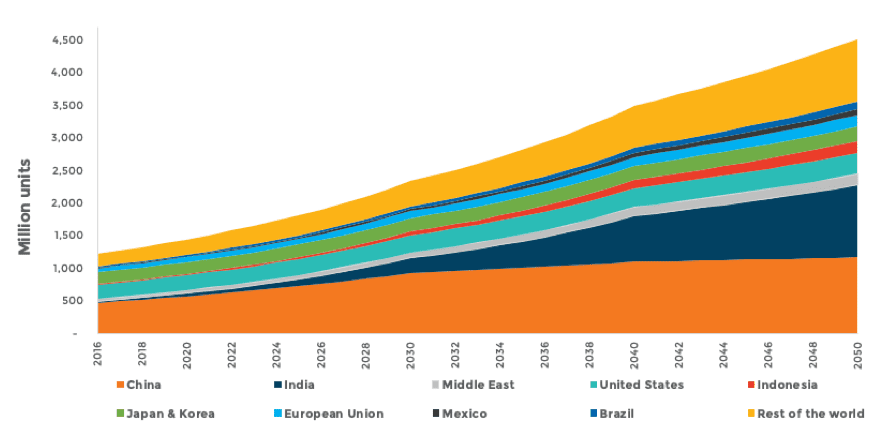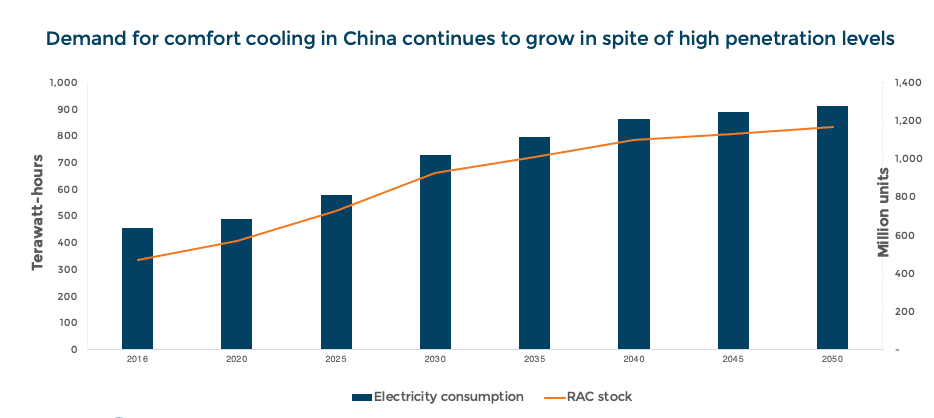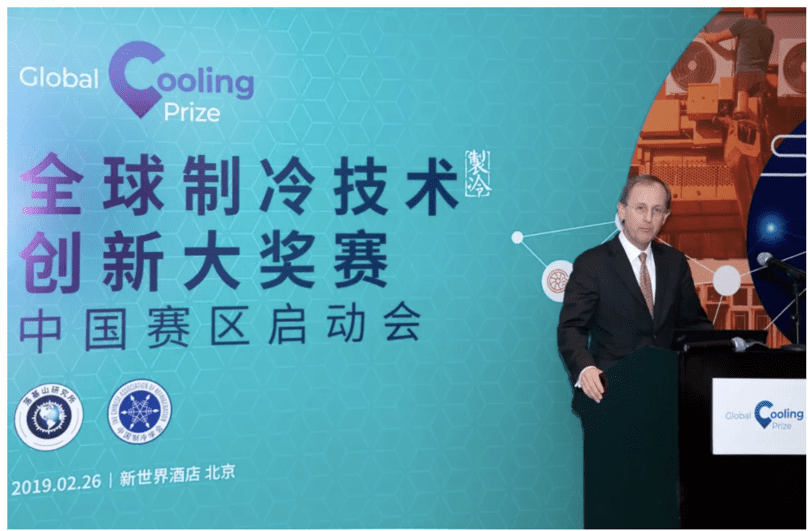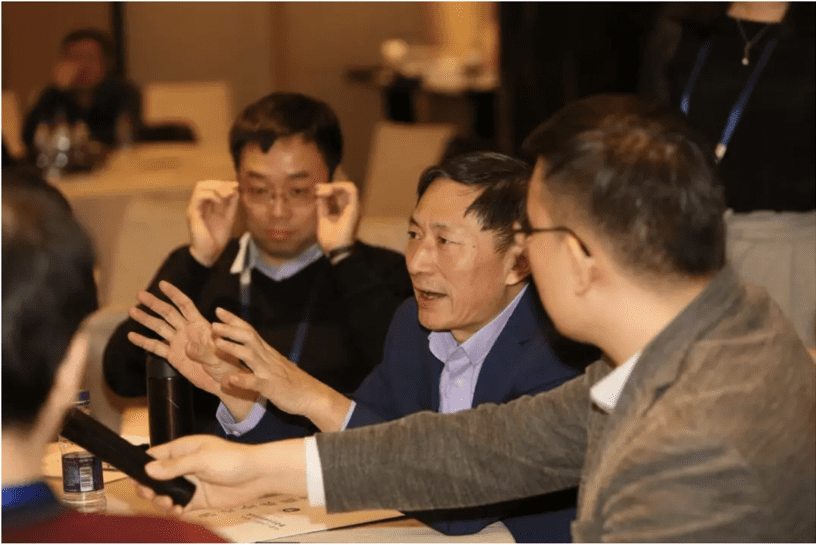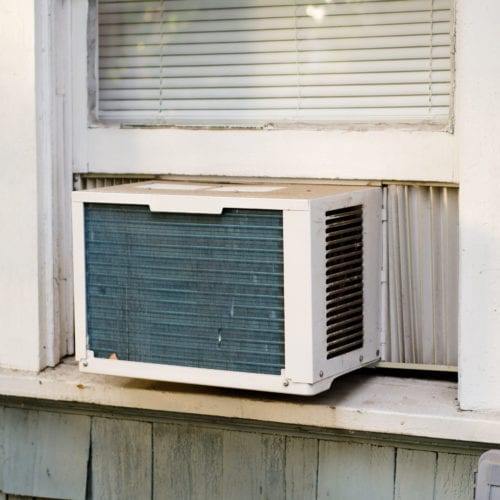Windows and balconies of residential buildings with lots of air conditioning and clothes hanging at windows in rural modern Beijing, China.

Transforming the Global Comfort Cooling Market: China’s Opportunity for Economic and Climate Leadership
Cooling is becoming a hot topic in discussions related to mitigating climate change as it is possibly the single largest end-use risk to our climate goals. With temperatures rising due to global warming, compounded by rapid urbanization and increasing income levels, exponential growth in demand for comfort cooling shouldn’t come as a surprise to anyone. After all, in many parts of the world, access to cooling is increasingly being viewed as a basic human necessity, enhancing health, comfort, and productivity.
Keeping ourselves and our homes thermally comfortable is critical to ensure that we live well and work efficiently, and one machine that is becoming ubiquitous to serving this need for comfort in tropical and subtropical parts of the world is the room air conditioner. Today, there are already about 1.2 billion room air conditioners (RACs) operating in the world—expected to quadruple to about 4.5 billion by 2050. This means that three new RACs will be purchased every second for the next three decades.
Figure 1: Global room air conditioner stock by region 2016–2050
Yet, many people do not realize that the combination of energy that these appliances consume and the refrigerants that leak into our atmosphere further exacerbate the global temperature rise and could result in over 0.5°C of global warming by the end of the century. So, while providing cooling to all is increasingly viewed as necessary for better health outcomes and driving economic development, we cannot allow it to result in runaway climate change.
Recognizing the urgent need to solve this cooling challenge, Rocky Mountain Institute (RMI), the Government of India, and Mission Innovation initiated the Global Cooling Prize at the Global Cooling Innovation Summit in November 2018. The objective of this prize is to identify a superefficient and climate-friendly RAC technology that, when scaled across markets, will neutralize the climate impact resulting from the soaring demand for these appliances. The initiative has received a great response from a global coalition of leaders, governments, research institutes, nonprofit organizations, innovators, and climate advocates. The industry has also risen to the challenge and many manufacturers are actively looking to participate in this prize to bring about a cooling revolution.
China’s Opportunity to Lead the Global RAC Market
One such market that has the opportunity and potential to revolutionize the AC industry globally is China. China is the largest manufacturer of RACs in the world today—70 percent of all RACs globally are manufactured in China. It is also the largest market in the world in terms of the number of RACs sold annually. This makes China well positioned to take a leadership role in driving the manufacturing and sale of breakthrough RAC technology.
China has experienced a rapid growth of RAC penetration in a relatively short time owing to rising per capita GDP and urbanization: the household ownership of RACs has increased from 3.5 percent in 1995 to 60 percent in 2018. And if you happen to be in Beijing, you can actually see at least two outdoor units of air conditioners hanging on the outer wall of many of the high-rise residential apartments.
In RMI’s recent report Transforming the Global Comfort Cooling Market: China’s Opportunity for Economic and Climate Leadership, we find that in spite of the relatively high penetration levels today (about 450 million units in 2016), China’s RAC stock will continue to grow and is expected to reach an installed base of over one billion RACs by 2050. While the more efficient variable speed-based inverter technology RACs are becoming increasingly popular in China, the lower first-cost preference by consumers continues to be a major hurdle in radical improvement in technology efficiency. The result is that the average efficiency of variable-speed RACs being sold today is still only around 60 percent of the best available RAC technology, which in itself is significantly below the maximum possible theoretical efficiency.
In a business-as-usual scenario, this demand for comfort cooling in China will result in doubling the country’s electricity use from RACs alone to 910 terawatt-hours (TWh) by 2050—this is more than the total electricity consumption of China’s residential sector in 2016. Globally, it is estimated that 2,000 gigawatts (GW) of new generation capacity would be needed by 2050 to supply the electricity required to operate the global stock of RACs annually—equivalent to adding three new countries to the world with the current annual electricity consumptions of the United States, Japan, and Germany.
Figure 2: Room air conditioner (RAC) stock and associated electricity consumption in China by 2050
The Global Cooling Prize
It is evident that China, as a global market leader in manufacturing of RACs, is well positioned to lead the world’s transition toward much-needed radically efficient and climate-friendly cooling solutions. Recognizing this, RMI hosted a Global Cooling Prize event in Beijing last week to engage with critical stakeholders and to call upon air-conditioner manufacturers and innovators in China to participate in this innovation challenge.
The event was attended by a senior delegation from the Chinese government, leading industry organizations, RAC manufacturers, academic and research institutes, and international organizations. Mr. Wang, deputy director general of the National Development and Reform Commission (NDRC), and Mr. Yang, director of the Ministry of Industry and Information Technology (MIIT), gave the keynote address and expressed their appreciation for the prize as an important initiative while encouraging Chinese innovators and industry players to actively participate. Mr. Meng, secretary general of the China Association of Refrigeration, shared his enthusiasm for cohosting this event with RMI and supporting the Global Cooling Prize as an Outreach Partner. Ms. Hu Min, program director, Kigali Cooling Efficiency Program-China (K-CEP), also applauded the Global Cooling Prize as an initiative that complements the work of K-CEP and helps to raise the bar through innovation. In his opening remarks, RMI CEO Jules Kortenhorst emphasized China’s role as a global leader in transforming the RAC industry and how its participation in the Global Cooling Prize is key to provide cooling for all without warming the planet.
During the second half of this daylong event, industry experts and prize organizers had detailed discussions on the technical criteria, testing protocol, and application process.
As the day concluded, I walked away from the event appreciating China’s leadership and interest in solving the cooling challenge through innovation and its forward-looking policies and programs. I also believe that industry and academia in China are well positioned to work together to develop innovative solutions that can transform the global air-conditioner market. I hope to see innovators and industry from China apply their expertise to developing and scaling a radically efficient residential cooling solution that has the potential to transform the AC industry and provide sustainable cooling to all without warming our planet.
